Coronary Artery Disease
POSTER SESSION #1
P055 - 10 MINUTE TRACING: A LITERATURE REVIEW TO IMPROVING ACQUISITION TIMES OF ELECTROCARDIOGRAMS IN EMERGENCY DEPARTMENTS
Thursday, October 23, 2025
5:30pm - 6:30pm ET
Location: Board 16

Andrea Schreckenbach, PA-S2, RNBN (she/her/hers)
Physician Assistant Student
Student
Winnipeg, Manitoba, Canada
Presenting Author(s)
Background: ST-elevation myocardial infarction is a type of acute coronary syndrome (ACS) that requires immediate diagnosis using an electrocardiogram (ECG) and timely reperfusion with primary percutaneous coronary intervention (PCI) or fibrinolysis. This expedited diagnosis is crucial in saving cardiac tissue, reducing mortality, and preventing future complications. The 2019 Canadian Cardiovascular Society (CCS) guidelines recommend for ECGs to be acquired and interpreted within 10 minutes from first medical contact (FMC). Despite this recommendation, real-world practice often falls short. The objective of this literature review is to investigate the strengths and limitations of several strategies that attempt to reduce the door-to-electrocardiogram (D2E) time in Emergency Departments (EDs). In literature, the common term is D2E time, which is equivalent to FMC-to-ECG time. Furthermore, this literature review also investigates which presented strategies are the most effective in improving acquisition times of ECGs for patients that present with ACS symptoms.
METHODS AND RESULTS: A literature search using key terms was performed using two databases; Medline and Embase, from 2014-2024, encompassing articles relevant to interventions for improving D2E times within EDs. This search yielded 9 articles that met the inclusion criteria. The results identified 5 key statistically significant interventions to reduce D2E time: Obtaining an immediate ECG for patients with ACS symptoms, having a dedicated ECG machine and technician for triage, triage staff education and optimization, using other team members to initiate ECGs instead of the triage nurse, and having regular interdisciplinary meetings and team communication.
Conclusion: While no single ideal intervention exists to improve D2E times, this review concludes that a combination of multiple strategies would be the most beneficial to improving D2E times. This review found 4 main steps to achieving optimal D2E times: A process to identify patients who require ECGs, having the proper infrastructure in EDs to accommodate a dedicated ECG at triage, initiating specific protocols to empower other staff members to identify patients with ACS symptoms, and maintaining ongoing education and communication with interdisciplinary teams. With these key concepts in mind, this type of quality improvement work should be a standardized approach tailored to each ED, grounded in strong team dynamics and communication. This will help attain optimal, yet realistic and sustainable D2E times. In conclusion, improving D2E times will help to meet the CCS guideline times of under 10 minutes and will positively affect patient care by enabling faster revascularization through PCI, reducing mortality, and preventing unnecessary complications.
METHODS AND RESULTS: A literature search using key terms was performed using two databases; Medline and Embase, from 2014-2024, encompassing articles relevant to interventions for improving D2E times within EDs. This search yielded 9 articles that met the inclusion criteria. The results identified 5 key statistically significant interventions to reduce D2E time: Obtaining an immediate ECG for patients with ACS symptoms, having a dedicated ECG machine and technician for triage, triage staff education and optimization, using other team members to initiate ECGs instead of the triage nurse, and having regular interdisciplinary meetings and team communication.
Conclusion: While no single ideal intervention exists to improve D2E times, this review concludes that a combination of multiple strategies would be the most beneficial to improving D2E times. This review found 4 main steps to achieving optimal D2E times: A process to identify patients who require ECGs, having the proper infrastructure in EDs to accommodate a dedicated ECG at triage, initiating specific protocols to empower other staff members to identify patients with ACS symptoms, and maintaining ongoing education and communication with interdisciplinary teams. With these key concepts in mind, this type of quality improvement work should be a standardized approach tailored to each ED, grounded in strong team dynamics and communication. This will help attain optimal, yet realistic and sustainable D2E times. In conclusion, improving D2E times will help to meet the CCS guideline times of under 10 minutes and will positively affect patient care by enabling faster revascularization through PCI, reducing mortality, and preventing unnecessary complications.
